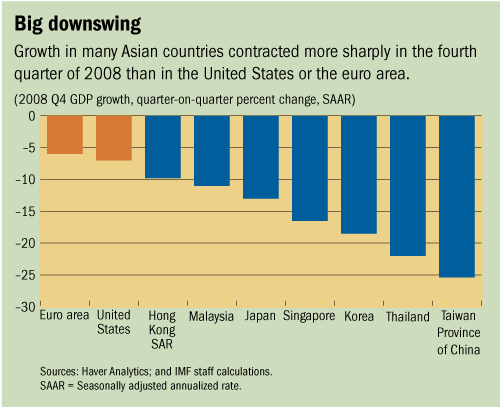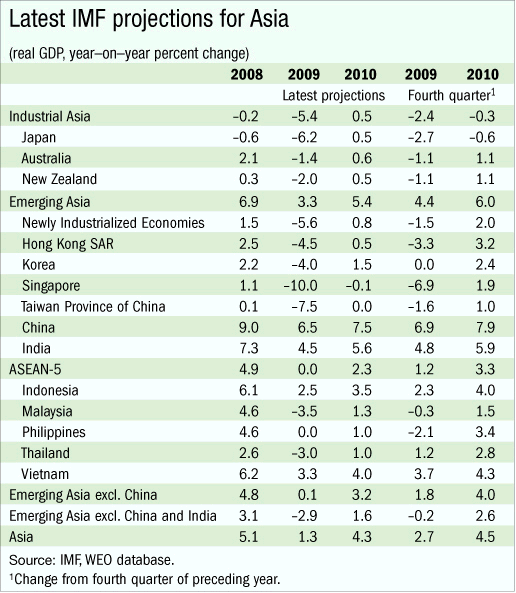
Typical street scene in Santa Ana, El Salvador. (Photo: iStock)
IMF Survey: Crisis Deals Sharp Blow to Asian Growth
May 6, 2009
- Asian growth to fall sharply to 1.3 percent in 2009 from 5.1 percent previous year
- Aggressive policy response in China to support domestic demand
- Rebalancing away from exports may be needed over longer run
The impact of the global economic crisis on Asia has been swifter and often deeper than for other regions, partly because of Asia’s export dependence and close integration into the global economy, according to a new report by the IMF.

Assembly line in Shenzhen, China: tightly integrated supply chain propagated external demand shock rapidly across Asia (photo: Ryan Pile/Corbis)
REGIONAL ECONOMIC OUTLOOK
GDP in emerging Asia, excluding China and India, plummeted by no less than 15 percent on a seasonally adjusted annualized basis in the last quarter of 2008, with the IMF forecasting an average decline for this category of Asian countries of 2.9 percent for 2009.
“In many ways, this severe impact was unexpected. Asia is far from the epicenter of the crisis, not just geographically but also in the sense that it did not indulge in the financial practices that led to serious problems in advanced economies’ banking systems,” the IMF said in its Regional Economic Outlook: Asia and Pacific, published on May 6. Moreover, before the crisis the region was in sound macroeconomic shape, and thus in a strong position to resist the pressures emanating from advanced economies. In the event, however, the impact on Asia has been even swifter and sharper than in other regions.” (see chart)
Collapse in demand for exports
The report said that the sharp impact of the global economic crisis on Asian economies is explained by the region’s exceptional integration with the global economy. The spillover has been amplified by Asia’s product mix, because the region is specialized in sectors particularly affected by the global credit crunch.
Much of Asia relies for its growth engine on high-and medium- technology manufacturing exports—in particular, motor vehicles, electronic goods, and capital machinery. The demand for advanced manufacturing has collapsed—Japanese auto exports, for example, have fallen by nearly 70 percent between September 2008 and March 2009. At the same time, Asia’s financial ties with the rest of the world have deepened over the past decade, exposing the region to the forces of global deleveraging.

Asia’s tightly integrated supply chain propagated the external demand shock rapidly across the region, reflecting the collapse in demand from advanced economies and having dramatic effects on intraregional trade. Between September 2008 and February 2009, merchandise exports fell at an annualized rate of about 70 percent in emerging Asia—about one and a half times more than during the information technology (IT) sector bust in the early 2000s and almost 3 times more than during the Asian crisis in the late 1990s.
Sharp deceleration
Overall, the IMF expects growth for Asia to decelerate to 1.3 percent in 2009 from 5.1 percent in 2008, and to return to 4.2 percent—still below potential—in 2010.
• In industrial Asia, Japan is expected to suffer a severe recession throughout 2009, experiencing the worst annual performance on record (see table). The strong fiscal response to the crisis will bring quarterly GDP growth back to positive territory in the second half of this year, but underlying growth will remain weak as the export collapse spills over to private domestic demand. Sustained positive growth will re-emerge only in late 2010, after the external environment improves. Meanwhile, large excess capacity in key manufacturing and export sectors, such as cars and electronics, means the production adjustment will be particularly difficult, especially since Japan’s financial conditions have become tighter than during the banking crisis of the 1990s. Australia and New Zealand will also see negative output growth on average in 2009, but are expected to return to positive growth toward the end of this year, thanks to their strong policy response, healthy financial sectors, and exchange rate depreciation.
• Like Japan, Asia’s newly industrialized economies are expected to go through a long and severe recession because of their high exposure to the global advanced-manufacturing cycle and their extensive global financial links. Among these economies, Korea is expected to rebound earlier and more strongly in 2010, as exports will benefit from the sharply depreciated exchange rate, and domestic demand will be supported by a forceful policy stimulus.
• In Southeast Asia, Thailand, Malaysia, and the Philippines are going to be hit more severely by the global crisis, owing their higher dependence on advanced manufacturing exports and large spillovers from the external sector to domestic demand, affecting consumers and investor confidence. In Thailand and Malaysia, growth will be negative on average in 2009 and will resume firmly only next year, as the effect of strong fiscal efforts eventually complement the improvement in global conditions. Growth is expected to be flat in 2009 in the Philippines, as waning remittances—an important driver of consumption—will dampen domestic demand. By contrast, growth in Indonesia and Vietnam will remain positive over the next two years, reflecting the relatively lower share of advanced manufacturing in these economies and the higher contribution to growth from domestic demand.
• For India, the report forecasts growth to slow markedly in 2009 before starting to rebound toward year end. Although its still relatively low dependence on exports will contain the transmission of the global demand shock, India will be particularly affected by the financial shock, because the strong investment growth in recent years owed much to favorable credit conditions. With external financing having tightened and the domestic credit cycle having turned, investment growth is expected to be severely curtailed, and so is GDP growth.
• In China, GDP growth will also slow notably from the average pace of the recent past. Still, the aggressive policy response is expected to support domestic demand and maintain growth at rates close to the level authorities consider necessary to generate jobs consistent with social stability. In particular, the massive program of public investment initiated late last year is expected to compensate for the decline in private investment and absorb productive resources no longer utilized in the tradable sector.
Tepid recovery
Looking ahead, Asia’s growth path will continue to run parallel to the global economy. For the rest of 2009, the external shock is expected to continue to spill over into private investment and consumption, causing many countries to register negative growth rates. Then, as the global economy revives in 2010, so too will Asia. But the recovery is likely to be tepid—and not only because the global economy will remain weak. Experience shows that investment tends to recover slowly from downturns, especially those that involve financial stress, the report says.

Over the longer horizon, Asian economies are at risk of a structural decline in demand from advanced economies. Households in advanced economies have started repairing their over-leveraged balance sheets, as the era of easy credit to finance purchases of consumer durables could well be over. In that case, the growth rate of Asian manufacturing and exports could be structurally lower for many years, and Asia’s export-led growth strategy may no longer pay the same dividends as in the past.
Challenge facing policymakers
The report points to two key challenges for policymakers:
• Forceful countercyclical policies should be sustained to help Asia come out of the recession more quickly and vigorously, and to provide insurance against downside risks. On the fiscal policy side, it will be important to sustain the stimulus injected in 2009 into next year, not least as an insurance policy against risks that have yet to reveal themselves. At the same time, it will be critical to preserve fiscal credibility by signaling that such stimulus packages are extraordinary and will be unwound once the recovery is firmly established. On the monetary policy side, many central banks still have scope to reduce policy rates, while some may need to support credit to the private sector through unconventional measures.
• Asia may need to rebalance growth away from exports and toward domestic demand in order to return to pre-crisis growth rates. China is already trying to catalyze private consumption, which has been falling for a decade relative to GDP. In principle, there should be scope to do this in many Asian countries, particularly by building stronger social protection systems that will reduce the need for precautionary savings to meet necessities related to health, education, and retirement. Over the longer term, exchange rate appreciation also might help—by providing price incentives to shift resources toward production for domestic use and by raising real household income, thereby spurring consumption, the report states.
Comments on this article should be sent to imfsurvey@imf.org







